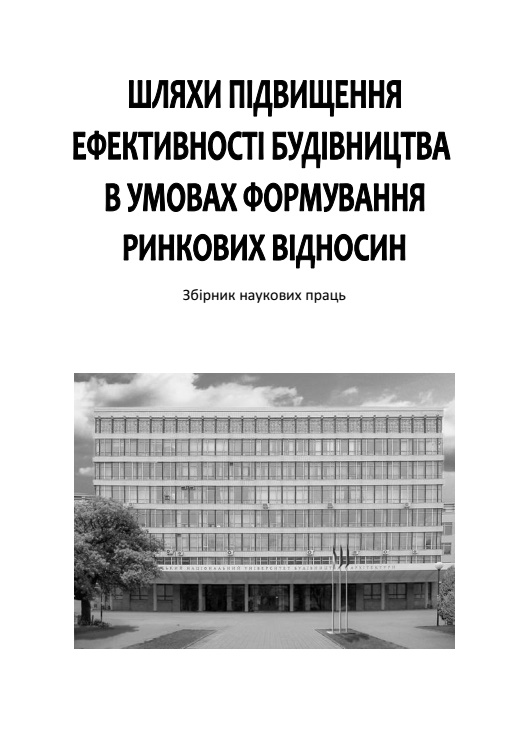Development of microstructure and hydration processes of concrete composites for structures with high durability
DOI:
https://doi.org/10.32347/2707-501x.2022.49(1).38-48Keywords:
concrete composite, durability of concrete composites, ultrafine modifiers, silica, metakaolin, quartz powder, X – ray diffraction, scanning electron microscopyAbstract
The main processes necessary for the development of microstructure and hydration of concrete and their composites for use in structures with high durability, frost resistance, water resistance are analyzed. The potential development that will ensure the strength of concrete and their composites, which have been modified by a complex of fine additives in the time range up to 365 days, has been determined. The experimental formulation of the concrete mixture, which was modified by a complex of fine modifiers based on microsilica (MK) and metakaolin (MTK), was used for testing. Concrete mixing technology has also been improved. The structure of ultra-high-strength concrete is formed during physicochemical reactions, which are accompanied by the binding of free water with clinker minerals, the formation of a saturated solution of crystal hydrates and their subsequent crystallization. Determining compounds of cement structure are such hydration products as: calcium silicate hydrate with various modifications, portland, calcite. For a more complete picture of the formation of hydration phases in high-strength concrete composites and the effect of ultrafine modifiers, the microstructure of fracture surfaces and their phase composition on the 28-day aging of concrete composites were studied by scanning electron microscopy and energy-dispersive X-wave spectroscopy.
Comparative microanalysis and elemental analysis of various concrete composites of high structural strength and density using the methods of X-ray diffraction and energy-dispersive X-wave spectroscopy. However, the presence of Al in the later stages of hydration can also lead to the formation of secondary phases. The molar ratio of CaO to SiO2 in C-S-H is one of the main parameters for determining and controlling the properties of the calcium hydrosilicate system, which can be used to characterize some parameters of concrete durability. The structure of concrete is actually the main factor that determines its mechanical properties and their security throughout the life of the structure. Regularities of formation of structure and properties are common to all types of concrete.
References
Сумарюк А.В., Гуцуляк И.И., Романкевич В.Ф., Михайлович В.В, Роман Ю.Т., Фодчук И.М. Влияние микроструктуры изломов бетона на прочность бетонных композитов высокой структурной прочности и плотности. Наносистеми, наноматериали, нанотехнологии. 2019. Т. 17, №4. С. 649–660
Сумарюк А.В., Романкевич В.Ф., Фодчук И.М. Перспективы получения ультрапрочных бетонных композитов введением полифункциональных наномодификаторов. Наносистеми, наноматериали, нанотехнологии. 2018. T.16, № 1. C. 103–115
Сумарюк А.В., Романкевич В.Ф., Роман Ю.Т., Фодчук И.М., Ткач В.М. Бетонные композиты высокой структурной прочности и плотности, модифицированные комплексом мелкодисперсных добавок на основе нанокремнезёма и метакаолина. Наносистеми, наноматериали, нанотехнологии. 2018. T.16, №1. C. 117–128
Adil G., Kevern J.T., Mann D. Influence of silica fume on mechanical and durability of pervious concrete. Construction and Building Materials, Vol. 247 (2020), p. 118453. 10.1016/j.conbuildmat.2020.118453
Barzgar S., Tarik M., Ludwig C., Lothenbach B. The effect of equilibration time on Al uptake in C-S-H. Cement and Concrete Research, Vol. 144, June 2021, 106438. https://doi.org/10.1016/j.cemconres.2021.106438
Poongodi K., Khan A., Mushraf M., Prathap V., Harish G. Strength properties of hybrid fibre reinforced quaternary blended high performance concrete. Materials Today: Proceedings. Vol. 39, Part 1, 2021, P. 627-632. https://doi.org/10.1016/j.matpr.2020.09.007. URL: https://www.sciencedirect.com/science/article/pii/S2214785320366797
Ozersky A., Khomyakov A., Peterson K. Novel ultra high performance concrete mixing technology with preliminary dry forced packing. Construction and Building Materials, Vol. 267 (2021), p. 120934. https://doi.org/10.1016/j.conbuildmat.2020.120934
Mohamed A.K., Moutzouri P., Berruyer P., Walder B.J., Siramanont J., Siramanont J., Harris M., Negroni M., Galmarini S.C., Parker S.C., Scrivener K.L., Emsley L., Bowen P. The atomic-level structure of cementitious calcium aluminate silicate hydrate. J. Am. Chem. Soc. 142 (2020) 11060–11071. https://doi.org/10.1021/jacs.0c02988.
Vandenberg A., Wille K. The effects of resonant acoustic mixing on the microstructure of UHPC. Second International Interactive Symposium on Ultra-High Performance Concrete, Albany, New York, USA, June 2–5, 2019. URL: https://www.extension.iastate.edu/registration/events/2019UHPCPapers/UHPC_ID15.pdf
Downloads
Published
How to Cite
Issue
Section
License

This work is licensed under a Creative Commons Attribution 4.0 International License.
Authors who publish with this journal agree to the following terms:
- Authors retain copyright and grant the journal right of first publication with the work simultaneously licensed under a Creative Commons Attribution License that allows others to share the work with an acknowledgement of the work's authorship and initial publication in this journal.
- Authors are able to enter into separate, additional contractual arrangements for the non-exclusive distribution of the journal's published version of the work (e.g., post it to an institutional repository or publish it in a book), with an acknowledgement of its initial publication in this journal.
- Authors are permitted and encouraged to post their work online (e.g., in institutional repositories or on their website) prior to and during the submission process, as it can lead to productive exchanges, as well as earlier and greater citation of published work (See The Effect of Open Access).

